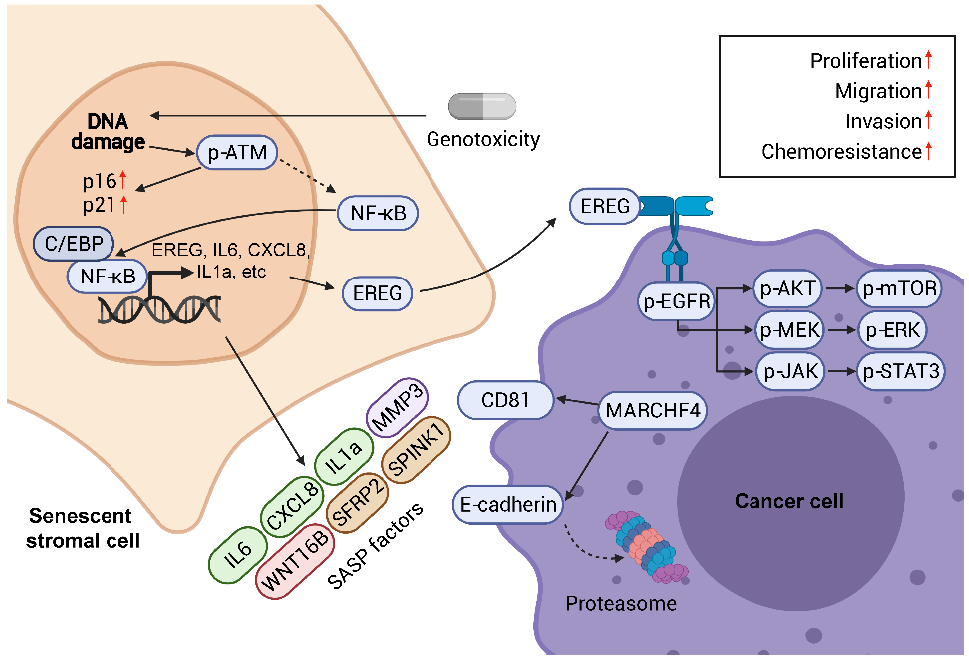A Recent study led by Dr. SUN Yu’s group in Shanghai Institute of Nutrition and Health (SINH) of the Chinese Academy of Sciences, reveals the roles and functional mechanisms of senescence-associated secretory factor epiregulin (EREG) in treatment-damaged tumor microenvironment, providing a new therapeutic target and noninvasive biomarker for treatment of human malignancies including prostate cancer.
Cellular senescence is a unique cellular state with many distinct and unique cellular features. Among these cell characteristics, the unique secretory phenotype of senescent cells, namely senescence associated secretory phenotype (SASP), makes it possible to play a complex signal transfer function on other cells in the microenvironment. This secretory phenotype has been found to contribute significantly to the progression of diseases in the elderly, including chronic inflammatory processes and the local space of the tumor microenvironment. Therefore, the study of SASP associated factors and their functions in tumor and other pathological microenvironment has far-reaching guiding significance for the clinical treatment of geriatric diseases.
In this study, researchers confirmed that EREG expression was significantly upregulated under senescence induced conditions of DNA damage type by senescence induction in primary human stromal cells. At the same time, the analysis of cancer samples from clinical prostate cancer and breast cancer patients before and after chemotherapy also found that EREG was significantly up-regulated in senescent paracancer stromal cells.
In terms of the mechanism, DNA damage induces nuclear localization of the transcription factor NF-κB in stromal cells and binds to multiple sites in the EREG promoter region, thereby contributing to the upregulation of EREG expression after cell aging. Other aging-related factors, including C/EBP activation, changes in DNA spatial openness, and epigenetic modifications, were also noted to promote EREG transcription. In the tumor microenvironment, EREG activates several signaling pathways including MAPK, AKT/mTOR and JAK/STAT by binding to EGFR receptors on the surface of adjacent cancer cells, and induces the aggravation of malignant phenotypes such as proliferation, migration and invasion of cancer cells and the occurrence of tumor drug resistance. Using RNA-Seq analysis, the researchers identified a ubiquitin ligase, MARCHF4, that was significantly upregulated in EREG-stimulated cancer cells. MARCHF4 can regulate the down-regulation of E-cadherin expression in cancer cells and inhibit the apoptosis of cancer cells, thus leading to the occurrence of drug resistance.
In a mouse model, the combination of EREG monoclonal antibody and EGFR monoclonal antibody significantly reduced tumor volume and significantly prolonged the progression-free period in mice. It is worth mentioning that EREG expression level in clinical cancer patients can effectively and accurately predict the efficacy of cancer treatment.
To sum up, this study elucidated the functions and regulatory mechanisms of a novel senescence-associated secretory factor EREG in tumor microenvironment and revealed its important value in translational medicine.
This work was published online with the title “Targeting epiregulin in the treatment-damaged tumor microenvironment restrains therapeutic resistance” in the journal of Oncogene on Oct. 6th 2022. Dr. SUN Yu from SINH is the corresponding author of this work. Dr. WANG Changxu form SINH and Dr. LONG Qilai from Zhongshan Hospital, Fudan University are the co-first authors.
The work was supported by grants from National Key Research and Development Program of China, National Natural Science Foundation of China and the public technology platform at SINH.

Illustrative working model of EREG expression in the chemotherapy-damaged TME.
(Image by Dr. SUN’s group)
Media Contact:
WANG Jin
Shanghai Institute of Nutrition and Health,
Chinese Academy of Sciences
Email: wangjin01@sinh.ac.cn
Web: http://english.sinh.cas.cn/

